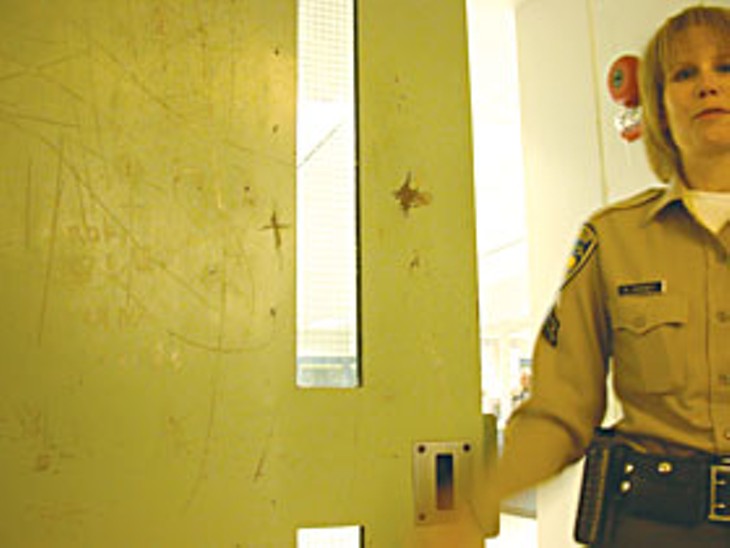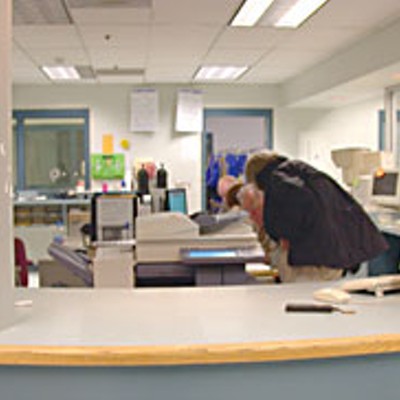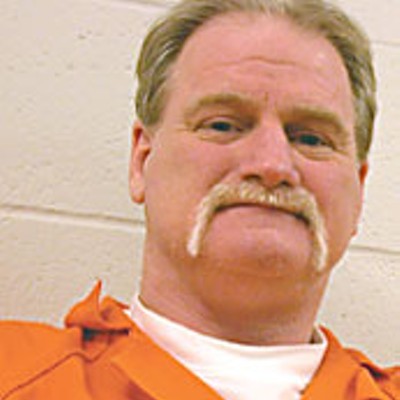[
{
"name": "Top Stories Video Pair",
"insertPoint": "7",
"component": "17087298",
"parentWrapperClass": "fdn-ads-inline-content-block",
"requiredCountToDisplay": "1"
}
]
The first thing you notice when you walk inside the Humboldt County Correctional Facility is the smell. It's overpoweringly sterile. "Pine-Sol," says Sgt. Dean Flint, walking briskly across the gleaming tile of the booking station. "This place gets mopped three times a day."
As one might imagine, people are not at their best when the cops bust them. DUI cases vomit on the floor and on themselves. Drunk-in-public transients come to jail in urine-stained clothes, wearing socks that could walk off on their own. Some "stink to high hell," says Flint.
On an average day 27 people are brought to the Humboldt County Jail and 25 are released, but right now, at 9 a.m. on Thursday, May 23, there's little activity in the booking station. At this moment, only one guy is here, sobering up. He's been patted down, fingerprinted, photographed, entered into the computer and nowhe's slumped in a bolted-down plastic seat, shoeless. He's either sleeping or watching TV; from this angle you can't tell. On the back of his T-shirt there's a peace sign. Whether he realizes it or not, his life is going to be different. He's in the system now, he'll have fines to pay, rehab classes to attend, probation restrictions to adhere to, and if he doesn't do these things -- more jail time.
Flint's still preoccupied with the topic of cleaning products and hygiene when Public Information Officer Brenda Godsey interrupts. Godsey (above) is also a senior correctional officer and works in the jail on weekends. But in her main role as PIO, she deals with the media.She arranged this tour of the jail for me. Her job, essentially, is to represent the Sheriff's Department well, and she reminds Flint that his gross-out stories might wind up in the paper. He gets the hint and wraps up his point with some finesse: The best officers, he says, are compassionate people. "We have a mission to treat people with dignity," he says. "And if a guy has poop in his pants, we'll launder his clothes."
The Humboldt County Correctional Facility (HCCF) is that salmon-colored behemoth in the center of Eureka -- hence its moniker as the Pink House. It was opened in 1996, right next to the old jail, which now houses the District Attorney's offices.
The new jail -- modern, mostly dorm-like -- is hardly the picture of prison life portrayed in the movies. Serious criminals don't spend much time here. The maximum sentence you can serve is one year. More serious offenders, felons mainly, are transported to San Quentin.
The jail can hold up to 410 inmates and often hovers at maximum capacity. In particular, the women's housing units are almost always at their limit. Overcrowding is a problem that the entire California prison system is wrangling with right now. Last month, after facing a federal takeover of the state's ailing prison system, Gov. Arnold Schwarzenegger signed AB900, which calls for $7.7 billion to add 53,000 more beds to state prisons, county jails and "re-entry" facilities where inmates can learn to adjust back to life on the outside.
Critics of the plan say that Schwarzenegger's "bigger is better" policy won't relieve California's overcrowded prisons. Instead, they say sentencing reform is the only real solution.
Humboldt County Jail, it seems, is a microcosm of the state's struggles. On days when capacity is exceeded, temporary beds are brought into the dorms; sometimes, Sheriff Gary Philp says, criminals of lighter crimes are turned away. And when beds at San Quentin are filled up, inmate transfers have to stay in Humboldt County Jail longer.
Expansion at the Humboldt County facility, says Philp, is still years away. And even if the state kicks down money to expand the jail, an important questions remains -- how to staff it adequately? Currently, there are a dozen vacant positions for correctional officers, and if the jail gets bigger, the limited staff will just be stretched thinner. Meanwhile, Sheriff's deputies are handling more calls for service than ever -- in the past year alone the number has increased 19 percent.
A glance at the jail's population statistics for April, the most recently available, show that a majority of the inmate population are unsentenced male felons.
For instance, on April 15, 395 people were in jail -- 349 men and 46 women. Of them, 262 were men awaiting sentencing for a felony. Seventy-six men were unsentenced misdemeanor offenders. Ten were already sentenced with felonies and only one man was serving time for a misdemeanor.
The numbers broke down similarly for women: 27 unsentenced felony offenders, 17 unsentenced misdemeanors, two sentenced felons and zero misdemeanor convicts.
The average length of stay for an inmate at HCCF is 27 days for men, 16 days for women.
Flint and Godsey, by comparison, have spent years in this place. As we continue the tour, an Old Navy commercial loudly announces summertime. Women lounge poolside in affordable swimwear, sunbathing to danceable rhythms. "You make my world go around!" the song says over and over.
Inside the empty sobering cell (formerly called the "drunk tank") there's a steel toilet and a place to lie down. It's mostly made out of hard rubber. Flint raps his knuckles on the spongy wall, almost proudly. "If they fall they won't get hurt," he says. It's an unmemorable room aside from the thick steel door's etchings from former occupants: a cross, a heart, a star, and a "Rob luv Verna." Across the hall there's another rubber cell for suicidal inmates. Thankfully, that one is empty, too.
We've spent too long in the booking station, and there's still more to see, so we go quickly through a maze-like series of hallways and bolted doors. It's a disorienting experience. Air compression locks hiss as they unlatch and the doors thud definitively as they close. Neither Flint nor Godsey have a ring of keys you'd imagine a jailer to carry. The doors are remotely unlocked by someone on the fourth floor who's watching us on surveillance cameras.
We take the elevator to the control room where a woman sits before a dozen or so black-and-white monitors. She's watching all the hallways, using a touchscreen computer to unlock doors and move elevators. She was tracking us as we made our way toward her. It's almost like a virtual Nintendo and she watches the the screens with a gamer's intensity and focus. On a monitor of the pre-booking station where we just were moments ago, a new guy's been brought in. He's young, black, in handcuffs. His hoodie sweatshirt is hanging off one shoulder but he can't pull it up. It gives you a guilty feeling to watch him like this. But then, everyone here is being watched.
So, isn't this constant voyeurism a little creepy? No, says Godsey. She describes the surveillance as "a comfort" -- it's like having someone always watching your back. Flint agrees.
We head back into the hall where there's a view through glass walls of the housing units. To the left is the men's maximum security unit, where a small population of problem cases are housed. They're square pegs, in Flint's words. Guys who are violent, guys who scream about being Jesus Christ. They need to be kept to themselves. On the other side of the hallway, you can look down into dorm 320, one of the two-tiered, general population housing units for less serious offenders. Sixty-some odd men in orange live here, at least for today. They're not behind bars; they're free to walk around, sleep, play cards, watch TV, hang out. One female correctional officer is down there with them, supervising the entire room by herself.
In the prison world, this open floor plan is called "direct supervision." It's a more modern, more humane departure from the traditional double-bunk lockdown cells. There are five dorms in the HCCF. Some are for general population inmates, and others called "worker dorms" for inmates with jobs in the kitchen, laundry or with the Caltrans crew.
At the old Humboldt County Jail there were no dorms, just barred cells. According to Godsey, the old jail was a much more hostile environment, even though it was only half the size of the new jail. Inmates were angrier and officers were more tense.
"The benefit [of direct supervision] is that we, the officers, have more control, and a better understanding of the inmate population," Godsey says. "You see a decrease in stress of the officer, a decrease in vandalism, a decrease in noise. And what it is, is a humanizing experience too."
But what's keeping those guys from attacking that correctional officer right now?
Flint hesitates before answering. A few things, he says.
For one, they know assault will just get them more time tacked onto their sentence. For another, they have a rapport with her. There's a level of mutual respect. But, Flint adds, it still happens sometimes, though it's rare.
Looking down in 320, Flint points to the female officer, who's chatting with an inmate at one of the round picnic tables. She seems relaxed, comfortable with the situation, at ease with her surroundings. But not long ago, he says, an inmate snapped. "He had her down and was giving it to her and really beating her up," he recalled. It could have been worse if it weren't for the other inmates. They jumped in and hauled the guy off before he did any serious damage. "The inmates really have respect for her. They might not do that for everyone. They might not do that for me."
The three inmates of Godsey's choosing are in a visiting room, clad in standard orange jumpsuits, with their backs against the wall. Earlier, she told me she picked these men -- Eric Harmon, William Clark and Richard Pugh -- because she thought they represented a spectrum of inmates' experience. However, as they tell their stories -- briefly, since we only have a half-hour -- it is their commonalities rather than their differences that come more into focus. To varying degrees, they all share the belief that the justice system has set them up for failure.
Harmon is a 35-year-old construction worker and father who is serving time for driving on a suspended license and violating his probation. He got pulled over May 6 on his way to a state-mandated program for DUI offenders. He only had two classes left to finish when he was taken to jail.
What Harmon wants to know is this: How was he supposed to straighten up his act, get his license back, become a productive citizen and get back to work if he couldn't drive? Taking the bus around sprawling Humboldt County was too much of a hassle. So he took his chances and got caught driving. An officer recognized him on the road. Now he's back to square one, even though he was trying his best, he says. Meanwhile, his kids are staying with his father, who's ill. His wife can't take care of them because she's in Humboldt County Jail, too.
"If it wasn't for my dad right now, I would be going crazy," he says. "They'd have me in a rubber room." Something about his voice tells you he's not exaggerating.
William Clark, a 48-year-old auto technician with a handlebar mustache, sits in the middle of the three men dominating the conversation. He says he's frustrated by what he calls his Catch-22 predicament. Clark has a long rap sheet, most of which pertains to methamphetamine sales and trafficking. He's been paroled 17 times and once served a 30-month prison sentence. After he was released, he says, he "went right back to the same field." He's had plenty of job opportunities, but when they ask for his driver's license number, he has to kiss the job goodbye. Besides, what good is a mechanic who can't test drive a car?
"When a person gets out on parole they give you $200 and tell you to get home and report [to a parole officer]," he says. "You have no clothes, you have no place to live and you have nothing going for you in Humboldt County unless you want to go stay at the [Rescue] Mission. I'm not a Mission person. I'm not gonna do it. I'm gonna go back to my old habits. Which is drugs, selling drugs."
The youngest of the group, 20-year-old Richard Pugh, of Eureka, backs up Clark's assertion.
"I was making $16.50 an hour at Schmidbauer Lumber -- that's $3,000 a month," Pugh says. "He [Clark] can make that selling drugs in a day."
Pugh, an athletic-looking guy with a fresh scar on his forehead, says he also was brought to jail for violating his probation. That was his second trip to the Pink House. The first time was for stealing a car. He says he was into drugs at the time, looking "sucked up" -- another term for really thin. He turned himself in. After he got out, he says he was "doing very good," staying out of trouble mostly. But then one night on Buhne Street some guys -- his ex-girlfriend's new boyfriend and some buddies -- tried to start a fight. Pugh ran. At the back of a house, he tried to open a door and busted it. The Eureka Police Department arrested him for vandalism and making threats [his aggressors claimed he was threatening them with a gun; he denies it]. The threat charges were later dropped but he still had to serve a little over a month in prison and attend Crossroads, a drug rehab program in Eureka.
So what's going to keep these guys from messing up again?
Pugh was the only one with an immediate answer. He says he wants to play sports and finish his education. When he was arrested this last time, he was just a few days from graduating from Eureka Adult School. He wants to go to junior college now, and play baseball. The coach from Siskiyous even visited him in jail. His mom's also been supportive of him this whole time. "I'm a momma's boy," he says. "My mom raised me."
But for Harmon and Clark, they're clearly wary of what will happen to them when they get out. It can be tough out there, and sometimes it seems like all the odds are against them.
A former inmate, who served a three-month stint for a DUI and drug charges in Humboldt County Jail last year, agreed to be interviewed by the Journal on the condition of anonymity.
Inmate X worked in the laundry facility at the jail and lived in the workers' dorm, housing unit 355. He's a self-employed carpenter and father in his 40s. He says he was never able to adjust to life in jail the way some of his fellow inmates were. It was oppressive, and emasculating.
"When you're inside," he says, "you can't tell whether it's day or night. It becomes timeless, almost. They turn the lights on sleep cycle but it's never really dark in there. You have to sleep with a towel over your head. Everybody in there for any length of time is as white as a ghost. You don't see the sun."
Since his release from jail, Inmate X has gotten his life back together. But he sees how it can be hard for some people not to re-offend. "If you've ever been on the wrong side of the law, and by nature you're not a conformist, if you're a wild guy, it can be really tough to stay out of the system," he says. "Suddenly, you get out and you have to start behaving better than the average citizen because the consequences keep getting more and more dire. You see people who fuck up as teenagers and then they're at the wrong place at the wrong time and they keep coming back."
He says he saw other guys get busted intentionally, just to have a roof over their heads, for the meals and regular showers. "They almost enjoy being there. Not me. It had a really negative effect on me. I got really depressed and there's not much that can be done. The nurses can be sympathetic and that's about it."
In particular, the forced segregation got to him. Mixing with other races was basically forbidden by other inmates, he says. You learn fast that white "shotcallers" beat up other whites for hanging out with minorities. "You have to get savvy right away," he says. "I hung out with the white nerds. I'm a white nerd. It's awkward to categorize yourself like that but you have to get over yourself. You're pigeonholed in jail. You're this or that or the other."
And if you're getting beaten up in the bathroom for one reason or another you better not make a sound, and you better not tell. Snitches just get more beatings. Don't bother moping around either.
"You don't show emotion," he says. "Everybody in there, in their heart is crying a little bit but no one wants to admit it. There's nothing you can do. To show your sadness brings other people down. You're almost responsible for everyone else's happiness. If you complain, it's like, 'Suck it up dude, be a man, grow a pair. You think its easier for me? I'm looking at 10 years, you asshole, so shut up.' No one wants to say how sad they are. Everyone is jovial ... but then there are ass beatings."
Paradoxically, Inmate X recalls how chivalry reigned in jail. Female guards were treated like queens, especially by the older inmates. "They were so polite to these women," he says. "Because, you know, they don't view themselves as bad people -- especially in Humboldt County Jail, especially in the dorms. They don't see themselves as criminals. They're dumb fuckups but they're still good men and they have all these rules of politeness."
After finishing his sentence -- three months in county jail and 90 days at Crossroads drug rehab program -- Inmate X went back to work and has stayed off drugs and alcohol since. It's been easy, he says, because he made a vow to his daughter never to abandon her again.
But like Eric Harmon and William Clark, he's had logistical barriers to overcome. "I had to get somebody to drive my tools to the job site, and I had to take the bus with my bike ... in the rain," he says. "Maybe I could have gotten away with driving. But it would just take that one time, one time getting caught and my life would be over."
Guys who take that chance, he says, are just born to lose.
Brenda Godsey leads the way back out of the jail, through the maze of automatically unlocking doors and echoey, windowless hallways. This can be disorienting, she says. In the winter months, she gets to work before sunrise and leaves after sunset. She's always in the dark. It's hard to get used to, she says, but it's part of the job and she likes her job, though she admits it's not for everyone.
We get to the last door and she lets me out. The sun is blinding, cars roar by; it feels almost foreign. Godsey turns and walks back inside.
Helen Sanderson also took the photos for this story.
Comments
Showing 1-1 of 1
more from the author
-
My Derby Daze
The girl-power sport on skates prepares to storm the county
- May 22, 2008
-
A sunbeam in the studio
- Jun 14, 2007
-
Trinity Terroir
- May 24, 2007
- More »
Latest in News
Readers also liked…
-
Through Mark Larson's Lens
A local photographer's favorite images of 2022 in Humboldt
- Jan 5, 2023
-
'To Celebrate Our Sovereignty'
Yurok Tribe to host gathering honoring 'ultimate river warrior' on the anniversary of the U.S. Supreme Court ruling that changed everything
- Jun 8, 2023



































